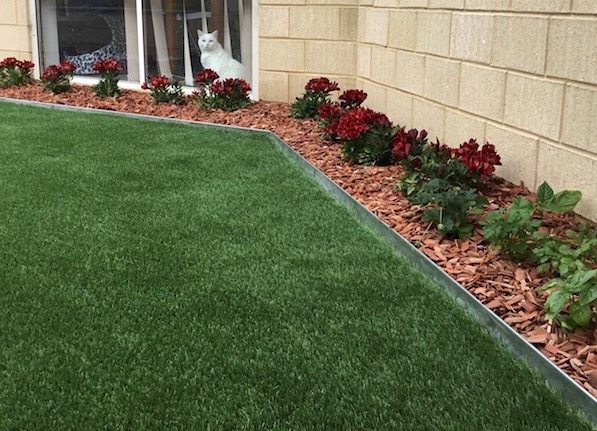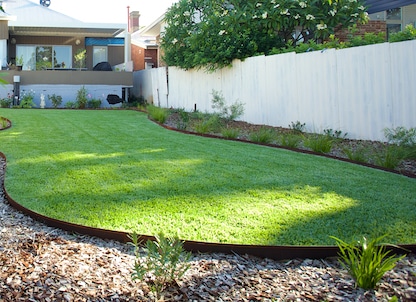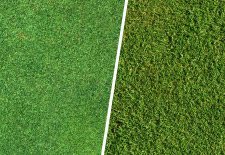There are many pros and cons to take into account when comparing synthetic lawn vs real lawn, and you need to decide which is the right choice for your property based on more than just looks.
Here are the main things to think about before making your choice between installing a natural or synthetic lawn.
Artificial Grass vs Natural Grass Lawn

When choosing a lawn, you need to think about price, looks, long-term goals, and drainage… while synthetic might seem the simpler or cheaper choice, there are aspects that might make it unsuitable in the long term, so it’s important to take all points into consideration.
Things to consider include:
Location and Maintenance
Synthetic lawns are often suitable for places where a real, natural lawn won’t thrive, such as indoors, on verandahs and patios, underneath shade covers and in high-traffic areas. If you don’t have the time or inclination to care for real grass, you might decide it’s worth sacrificing the look and feel of a natural lawn for ease of care.
However, there are natural lawn varieties that can also suit these environments – for both full sun and shade. There are even varieties that are self-repairing and drought-tolerant. While it may take more maintenance, the benefits below may make it the right choice in the long run.
Cost – What Is Your Initial and Long-Term Budget?
Initially, the difference in cost is quite significant. Synthetic lawn can cost between $75 and $100 per square metre while real lawn is significantly lower at around $10 per square metre. However, the ongoing maintenance costs of an artificial lawn are minimal while natural lawns will incur costs such as mowing, weeding, watering and fertilising.
Natural turf can also be laid DIY relatively easily, which might save you money on installation, whereas artificial lawns can be extremely difficult to lay. Getting the joinings correct and the correct instructions to ensure it takes and doesn’t die off, and many people choose to have professional installation for guaranteed results, which of course is an extra cost.
But, as we all know, time is money and both installs require a lot of hard yakka, as well as the right preparation and tools, so outsourcing to professionals for installation can save you time, money and a lot of hard work!
What Look Do You Value?
It’s true that a natural lawn may, at times, not look as lush and green as an artificial lawn, but there are varieties available that have been cultivated to maintain a year-round colour. With the proper care and irrigation; for example, a drip line you won’t see or have to think about, your lawn can stay healthy and green, with that healthy, natural look only real lawn can provide to your garden.
Synthetic lawns have come a long way over the years and now have a much better and more realistic look but do still maintain an unnatural shine. At the end of the day, your guests are going to know your lawn is fake – so is that important to you?
What Texture and Feel Do You Want From Your Lawn?

Both types of grass can provide a lawn that is soft and comfortable however it comes down to the fact that one is made of plastic and the other is natural and it is up to you which of these you prefer.
The major difference in the feel will become apparent during the warmer months when a synthetic lawn will heat up, possibly to the point that you shouldn’t let small children and pets play on it. A real lawn will remain around 15 degrees cooler and will act as a natural air conditioner for your whole property during hotter months. Plus, you can’t beat the feel of bare feet on cool, natural grass!
What Environment Do You Want?
An artificial lawn will not act as a filter to prevent pollutants from getting into waterways, does not work as a natural fire break around your home or absorb carbon and cannot produce oxygen as a natural lawn will.
Real lawns will require pest and weed control and fertilising, but you can choose whether you use chemicals or natural alternatives. But, if you chose chemical, the runoff will need to be controlled to ensure the chemicals do not reach the waterways. A natural environment is proven to be good for our physical and mental health and is especially important for children and pets to have real grass to play on.
What Level of Maintenance Can You Provide?
A synthetic lawn may seem to be maintenance-free but that is not true in the long term. Synthetic lawn will also require ongoing maintenance but in the form of brushing, and cleaning, particularly if you have small children and pets, as well as refilling twice a year to keep the grass blades standing up straight. Many people who have pets find that synthetic lawn ends up smelling and they don’t want to walk on it themselves after a while!
A real lawn requires ongoing care – mowing, weed control, pest control, fertilising, aerating and watering – to stay healthy and green. But if you are wanting a lush, natural environment for your family, it’s worth the extra effort. Read more here for
Some final thoughts on Synthetic Lawn vs Real Lawn for Your Garden
Synthetic lawns can be a great option for those suffering from allergies and won’t attract bees and other insects, however, this may affect the rest of the plants in the ecosystem of your backyard.
Natural, real lawn gets our vote here at Perth Landscaping – you just can’t beat the look and feel of real, lush green grass as the centre of your garden design. It’s better for the environment, keeps the pets happy, cools down your backyard and feels great to run and play on. Here are some expert lawn care tips from our sister company Perth Gardening Experts.
Artificial lawn has its place as a low-maintenance option, for cafes or apartment verandas, but, if you can put in that little bit of extra work, we’d go for natural lawn every time.
Need help choosing the right lawn for your property?
Talk to our team at Perth Landscaping to further discuss which option, natural or synthetic lawn, is best for your space, lifestyle and design goals.

